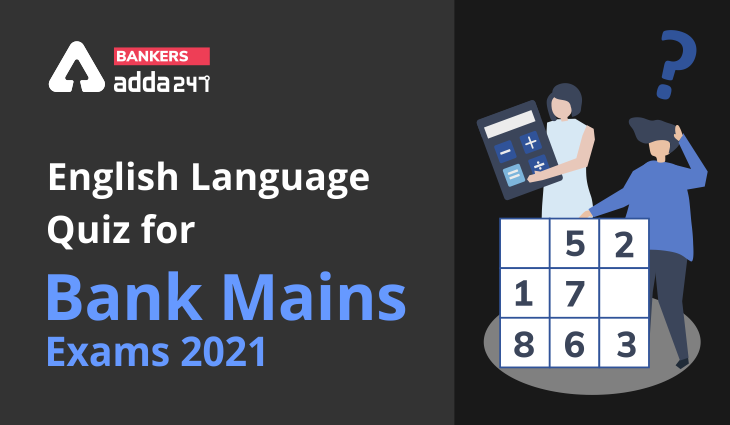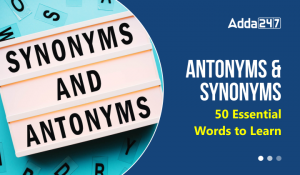
Directions (1-5): Five statements are given below, labelled a, b, c, d and e. Among these, four statements are in logical order and form a coherent paragraph. From the given options, choose the option that does not fit into the theme of the paragraph.
Q1. (a) The eight richest people in the world own half its wealth.
(b) India’s population has touched $1.3 billion mark and its economy is valued at up to $3 trillion.
(c) According to a study done by Oxfam, the richest 1 per cent of Indians owns 58 per cent of its economy.
(d) Now a wealthy person is idealised as a smart, intelligent person capable of making money.
(e) There was a time when a majority of the population used to believe that the disproportionate distribution of wealth was organised loot and there was regular rich-poor conflict.
Q2. (a) Science fiction loves and fears the hardware littering its worlds.
(b)Actually, humankind has not evolved biologically in the last 20,000 years, but surged ahead through mental products like politics, culture and technology.
(c)Our fascination with labour-saving devices is reflected in machines which slavishly tend to humans.
(d)And there is dark talk of the singularity — the point at which machine intelligence passeth human understanding, and reality baffles us.
(e)But the possibility of machines replicating and taking control inspires anxiety.
Q3. (a)The BJP’s astounding performance in the elections to the municipal corporations and other local bodies in Maharashtra and Odishashows that the party’s juggernaut is simply unstoppable.
(b) The Maharashtra and Odisha results and other electoral successes in the recent past demolish the theory that the BJP’s electoral fortunes would dip in the wake of demonetisation.
(c)There is overwhelming support, throughout the country, for Prime Minister NarendraModi and his people-centric policies.
(d)The BJP’s electoral base has remarkably cut across the urban-rural divide.
(e)From Andaman and Assam to the latest round of local body polls, the narrative has been similar.
Q4. (a)“No hate, no fear, refugees are welcome here.”
(b)His executive order — now stayed by the courts — suspended the entry of all refugees for at least 120 days and those from Syria indefinitely.
(c)This protest anthem emanated from demonstrators gathered outside the White House, in front of the Statue of Liberty, and in airports across the United States, hours after President Donald Trump temporarily limited the entry of Muslims from seven Muslim-majority countries.
(d) The voices of public protest across India have been far too muted and infrequent.
(e)It also stipulated that among refugees let into the country, Christians will be prioritised over Muslims.
Q5. (a) It is worth checking out the number of Indian immigrants to these five countries
(b) If citizens are happier in a certain country, presumably people would want to migrate there, given a choice.
(c) Among India’s states, Madhya Pradesh was the first one to start a happiness department in 2016.
(d)The initial idea seems to have been to converge anti-poverty programmes directed at disabled, homeless, poor and old-age pensioners.
(e) In 2016, the top three countries were Denmark, Switzerland and Iceland and both Nepal and Bangladesh have higher ranks than India.
Q6. (a) Separately, officers from the States and the Centre are expected to finalise, by this weekend, drafts for four pending regulations out of a total of nine, that lay down the administrative procedures and processes to be followed by taxpayers under the GST regime.
(b) The Council will meet again on March 31 to consider those drafts.
(c) Finance Minister Arun Jaitley has said the Union Cabinet will soon take up the four laws that the Centre has to steer through Parliament, while the respective State governments will take up the State GST law.
(d) This will give the Centre enough buffer to make the transition to the new system.
(e) Giving lakhs of enterprises just about two months to switch to the GST regime, with all its implications for supply chains, pricing strategies and accounting systems, could lead to a messy start.
Q7. (a) China’s statement that it is “gravely concerned” over the government’s decision to allow the Dalai Lama to visit Arunachal Pradesh’s Tawang monastery in early April, and that it would “seriously damage” bilateral ties, is unwarranted.
(b) The controversy over the Tawang area goes back to the Shimla meet of 1914, when the Chinese representatives just initialed, and didn’t sign, a trilateral agreement with British India and Tibet.
(c) It is also an unacceptable escalation of rhetoric over an issue that India and China have engaged with each other on, including during the visit by Foreign Secretary S. Jaishankar to Beijing.
(d) At the same time, New Delhi must calibrate its moves to avoid misperceptions that it is indulging in political power-play.
(e) Later, in 1959, when the current Dalai Lama fled Tibet, he came into India through Tawang.
Q8. (a) After the discovery, the scientists placed the genes into yeast and bacteria, which then developed the similar proprties as the tardigrades.
(b) Boil them at temperatures up to 150 degrees, but these tiny, Muppet-like creatures just won’t die.
(c) Tardigrades, also known as moss piglets or water bears are the toughest animals in the world.
(d) They can live just anywhere, from deep oceans to a high mountain.
(e) Freeze them to absolute zero temperature, they will still survive.
Q9. (a) As a result, there should be little to comment in the normal course when India accepts Pakistan’s invitation to the next round of talks, as it has for the Permanent Indus Commission in Lahore later this month.
(b) Under the treaty, India has full use of the three “eastern” rivers (Beas, Ravi, Sutlej), while Pakistan has control over the three “western” rivers (Indus, Chenab, Jhelum), although India is given rights to use these partially as well for certain purposes.
(c) In September last year, doubts had been raised over India’s commitment after the terrorist attack on an army camp in Uri, killing 19 soldiers.
(d) The commission has experts who look into issues and disputes on the ground over the utilisation of the waters of six rivers of the Indus system.
(e) Even in the fraught and volatile framework of India-Pakistan ties, the Permanent Indus Commission mandated to implement the 1960 Indus Waters Treaty (IWT) has met like clockwork, 112 times in 56 years, annually in each country.
Q10. (a) According to the proposal, a driving performance test will be conducted first to evaluate fuel efficiency “in terms of kilometre or litre by using suitable set up and test procedure.”
(b) The drivers will be required to attach the training certificate at the time of applying for a license for driving heavy goods vehicle or heavy passenger motor vehicle, according to a draft notification to amend the Central Motor Vehicles Rules, 1989, dated February 21.
(c) Beginning April 2018, the Road Transport and Highways Ministry has proposed a training programme for drivers of heavy commercial vehicles to help them save fuel while driving which would include classroom lessons and driving performance tests.
(d) The PCRA has trained 1.70 lakh drivers till 2010 and claims it led to fuel savings worth 650 crore.
(e) Truck and bus drivers will soon have to undergo training in fuel efficient driving at the time of applying for a new or renewed driving license.
Directions (11-15): Five statements are given below, labelled a, b, c, d and e. Among these, four statements are in logical order and form a coherent paragraph. From the given options, choose the option that does not fit into the theme of the paragraph.
Q11. (a) Such deregulation would lead to imitation elsewhere, jeopardising the hard-won gains in ensuring financial sector stability.
(b) The burden of reviving growth in such a situation falls on fiscal policy. This means running up large government deficits and increasing public debt.
(c) In conditions of ‘secular stagnation’, conventional monetary policy is doomed to be ineffective.
(d) Where the nominal interest rate is already close to zero, there isn’t much scope for cutting interest rates.
(e) Conventional monetary policy operates by reducing nominal interest rates in order to stimulate growth.
Q12. (a) Rarely has this assumption been challenged.
(b) In particular, every State should set up a State Security Commission — Kerala has one — to both guide the police and decide on top police appointments and transfers.
(c) In the event of a regime change following an election, new political dispensations assume they have an unfettered right to reshuffle officers in the civil and police services.
(d) Despite this, State governments have failed to protect Directors General of Police from arbitrary transfers.
(e) In 2006, the Supreme Court ruled in the Prakash Singh case that the chief of a State police force should have a fixed tenure of at least two years.
Q13. (a) In 2012, the then Chairman of the U.S. Joint Chiefs of Staff, General Martin Dempsey, stated that attacking Iran would only delay Iran’s development of a nuclear weapon and not stop it.
(b)It may help India that within the U.S. and Israel, moderating factors — both commercial and military — obtain.
(c) With the attitudes taken by Israel and Saudi Arabia no doubt exacerbating New Delhi’s predicament.
(d) Oil is of course only one commodity in a long-standing Indo-Iranian trade relationship; Iran buys basmati rice and sugar from India, as well as various agrochemicals and petroleum products.
(e)The prospect of a more aggressive U.S. attitude on Iran, if not stronger sanctions against Tehran, will almost certainly make the Government of India very uncomfortable,
Q14. (a) It may have had no bearing on the attack, or the probability of averting it, but the fact that the post of the Director General of the CRPF continues to be vacant is a lapse amplified by the tragedy.
(b) The recent spate of attacks and ambushes indicates a breakdown in intelligence-gathering, possibly on account of a lack of effective coordination between the State police and paramilitary forces.
(c) The road under construction will provide easy access to the backward region, where Maoists have for long held sway.
(d) There is also a need to boost the morale of the security and police forces.
(e) The response must be to double down to extend the presence of the administration in Bastar, to break the isolation and reach social services to the people.
Q15. (a) The propensity to expand the universe of IP is not new: businesses have demanded patent protection for the way they do business;
(b) Motorcycle manufacturers have got into dispute over the trademark on the exhaust sound of motorcycles; and animal activists have fought for copyright in a selfie taken by a monkey.
(c) IP in the modern world defies definition, transcends boundaries and has become synonymous with ascribing value to things that we don’t fully understand.
(d) The issue of whether India should offer data exclusivity — one of the key issues discussed in the RCEP — is tied to our understanding of what amounts to IP and whether we are obliged to protect it.
(e) In countries where data exclusivity is granted, generic companies do not undertake such clinical trials and their versions of the drug accordingly stay off the market as long as the period of data exclusivity lasts.
Solutions
S1. Ans. (d)
Sol. Read the sentences, CABE forms a coherent paragraph. The paragraph is about richest people in the world that own half its wealth and richest people in India that owns 58 percent of its economy. Sentence (d) is not part of the paragraph as it talks about a wealthy person that represent as a smart, intelligent person which fails to connect with the other sentences of the paragraph. Hence sentence (d) is the right option.
S2. Ans. (b)
Sol. Going through all the sentences, we conclude that sentences ACED forms a coherent paragraph. The paragraph is all about labour saving machines that passeth human understanding. Sentence (b) talks about humankind that has not evolved biologically in the last 20,000 years, which is different in theme of the other sentences. Hence sentence (b) is the correct choice.
S3. Ans. (e)
Sol. Sentences ACDB forms a coherent paragraph. Theparagraph is about BJP’s victory in recent polls demolishes theories that its fortunes would decline after demonetization. Sentence (e) is not part of the paragraph as it is about the states Andaman and Assam which fails to connect with other sentences. Hence sentence (e) is the correct option.
S4. Ans. (d)
Sol. After reading the sentences, it can be inferred that sentences ACBE forms a coherent paragraph. This paragraph revolves around the theme of banning the entry of all refugees in U.S. and protests against Donald Trump’s decision whereas sentence (d) talks about protest across India that have been infrequent. Hence sentence (d) is not a part of the paragraph.
S5. Ans. (d)
Sol. Sentences BEAC forms a coherent paragraph while sentence (d) is not a part of the paragraph. The paragraph is about Happiness index which is topped by Madhya Pradesh in India and Denmark in world while sentence (d) is about anti-poverty programmes. Hence sentence (d) fails to connect with other sentences and is the correct choice.
S6. Ans.(e)
Sol. Option (e) is the correct choice and is not a part of this coherent paragraph, the other four options (a), (b), (c) and (d) are a part of the paragraph and their logical order is cabd. Option (e) is unfit, as it states a precaution that should be considered by the government in the implementation of GST while all other options explore plans made by government for the implementation of GST regime.
S7. Ans.(d)
Sol. Option (d) is the correct choice and is not a part of this coherent paragraph, the other four options (a), (b), (c) and (e) are a part of the paragraph and their logical order is acbe. Option (d) is out of context.
S8. Ans.(a)
Sol. Option (a) is the correct choice and is not a part of this coherent paragraph, the other four options (b), (c), (d) and (e) are a part of the paragraph and their logical order is cdbe. All of these options discuss the toughest creature “Tardigrades” .
S9. Ans.(c)
Sol. Option (c) is not a part of this coherent paragraph, the other four options (a), (b), (d) and (e) are a part of the paragraph and their logical order is edba. All of these options discuss the Indus Water Treaty.
S10. Ans.(d)
Sol. Option (d) is not a part of this coherent paragraph, the other four options (a), (b), (c) and (e) are a part of the paragraph and their logical order is ecba. All of these options are about using the fuel efficiently through trained driver. Option (d) is about PCRA, so it is out of context.
S11. Ans.(a)
Sol. Only option (a) is not the part of the coherent paragraphs. The options form a coherent paragraph with their logical sequence being edcb. The reason for option (a) for not being the part of the logical sequence is that other options are talking about the conventional monetary policy while option (a) talks about the ‘deregulation’ issue and therefore is not on the same wavelength.
S12. Ans.(b)
Sol. Option (b) is not the part of coherent paragraph even after being a part of the same article. The important thing to notice here is the context of the paragraph; other options are describing the issue
while option (b) is giving an example of one particular issue and therefore is not a part of the coherent paragraph.
S13. Ans.(d)
Sol. Option (d) is the correct choice and is not a part of the coherent paragraph. The logical sequence of the coherent paragraph is ecba. Option (d) is not the part of the coherent paragraph as other options are focusing on the issue of sanctions against Iran and its implications on India. Option (d) on the other hand is talking about one particular aspect of the relationship.
S14. Ans.(c)
Sol. Option (c) is the one which is not a part of the coherent paragraph. The logical sequence of the sentences forming the coherent paragraph is edba. Option (c) is incorrect as it is talking about the reason Maoists chose a particular location for their bombings. Other options are talking about the appropriate actions therefore option (c) is the odd one out.
S15. Ans.(e)
Sol. Option (e) is the correct choice for the given question and is not part of the coherent paragraphs. Other options are forming a coherent paragraph with their logical sequence being abcd. Option (e) is not in harmony with the context of the paragraph as it talks about the effect of data exclusivity on countries while other options are talking about why it is needed in the modern world.
Practice with Online Test Series for Bank Mains 2021:
Click Here to Register for Bank Exams 2020 Preparation Material



 English Language Notes for Competitive E...
English Language Notes for Competitive E...








